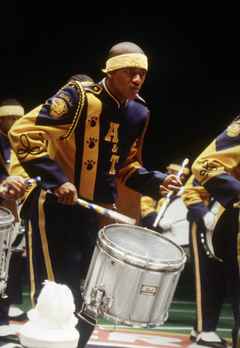

You can’t draw a house if you don’t know what a house looks like, just as you can’t program good drum patterns if you don’t know what good drums sound like. Which begs the most important question, how do you become good at programming drums? Listen, Listen, and Listen It doesn’t mean the track isn’t great, but it’s just somewhat of a disappointment. There are some beautifully composed tracks out there that fall short when it comes to drums, and it’s noticeable. If you didn’t notice, the heading for this section is called The Importance of Good Drum Programming. Why? Because the skills you learn through drum programming also apply to other facets of music production. You understand the balance between simple and complex.You’re great at choosing samples and manipulating them.
#DRUMLINE FREE STREAM HOW TO#
Learning how to program drum patterns, like anything else in the field of music production, is a lifelong process.īut there are key benefits to being a good drum programmer: It might be a certain technique, the use of polyrhythms, programming complex hi-hat patterns, trying to make your drums sound more human, and so on. When you go deep into drum programming, however, you find there’s a hell of a lot to learn. It’s not difficult to create a basic kick-hat-snare drum pattern. In that case, don’t you think we should put a fair bit of effort into programming them? The Benefits of Learning How to Program DrumsĪt its core, drum programming is easy. So, we can argue that groove is formed first and foremost with drum patterns. However, if you solo your drum section, then you’re going to have a groove. It needs to work in relation to something, i.e., drums. If you solo your bassline, it’s not going to have much of a groove. Though the two work together, there’s a significant difference between drums and bass in terms of their contribution to groove. How Groove is FormedĪll instruments and patterns in a song should contribute to groove, but there are two in particular that lay the foundation for it: drums and bass. Groove does not mean swing, it just means the track has a solid rhythm that people can identify with. Groove can take on many different forms a 175BPM drum and bass track can have groove, just as a 140BPM tech-trance banger can. People get hung up on this because they think groove means lowering the tempo to 125BPM and make a funky tech house track. Groove should be the basis for all your tracks, assuming your goal is to make people dance (by dance, I mean anything from tapping a foot to spinning with all limbs flailing everywhere). Without a solid groove, dance music is not ‘dance’ music, it’s just some other weird experimental form of music. There’s one musical element that’s fundamental to dance music… It differs from drum synthesis in that you’re not actually creating the sounds you’re using (though one could argue that drum synthesis is a part of drum programming).Īs a result, you create drum patterns, which you can loop, create variations of and arrange. You’re not playing live, you’re plotting out sounds in a particular sequence. These cover the tips in this article.ĭownload the Free Cheat Sheets What is Drum Programming?ĭrum programming is essentially composing with drums. Update: I’ve put together a pack of two cheat sheets that you can easily reference while producing. This is where we’ll analyze a track in each major genre (Trance, House, Drum and Bass, Future Bass, and Dubstep), studying the style of drums and giving a breakdown of how those drum patterns are programmed.

In fact, it’s quite often the most frustrating. The fun part of electronic music production.īut I’m sure you’ll agree with me when I say that drum programming isn’t always the easiest part of the process. Do your drums sound boring, feel stale, and lack punch? Create powerful, pro-level drums in any genre with Drums By Design.ĭrum patterns.


 0 kommentar(er)
0 kommentar(er)
